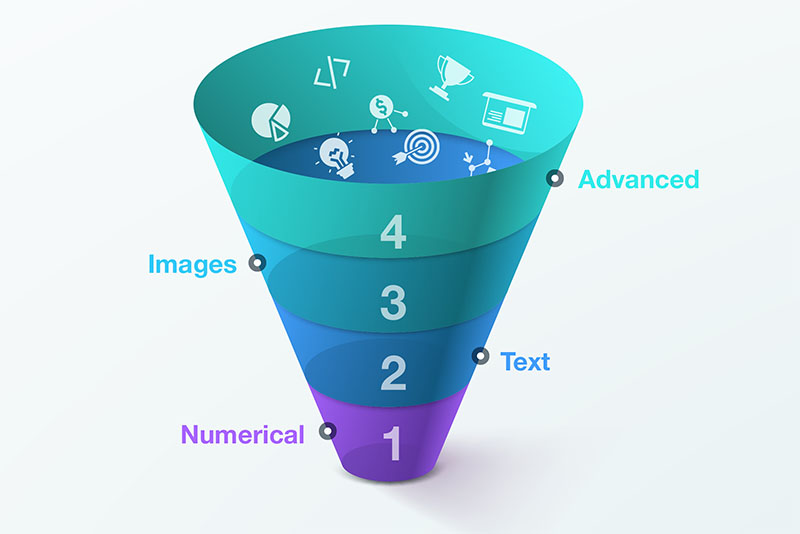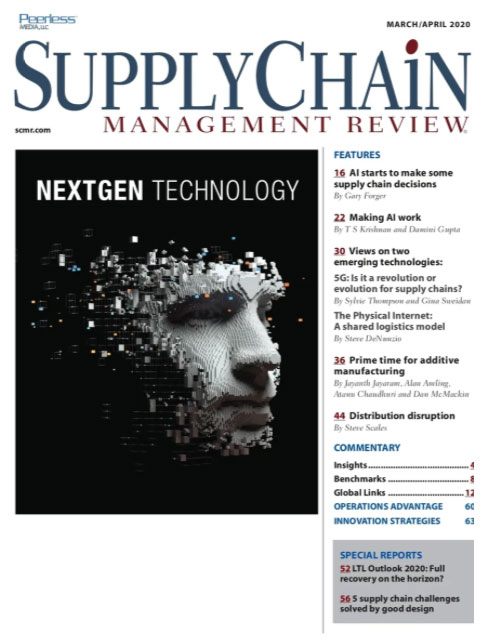Sorry, but your login has failed. Please recheck your login information and resubmit. If your subscription has expired, renew here.
March-April 2020
Are you ready for NextGen technologies? Just the other day, I had the opportunity to tour one of Amazon’s highly automated robotic fulfillment centers. I expected to be dazzled—and I was. But it wasn’t because of the automation. The tour was a reminder that there’s no question that NextGen technologies such as Artificial Intelligence, blockchain, robotics, 3D printing and 5G are going to be the differentiators in tomorrow’s supply chain. The question is: Are you ready? Browse this issue archive.Need Help? Contact customer service 847-559-7581 More options
Recent years have seen the convergence of data science and supply chain management. It has been driven by the increased utilization of business intelligence and Big Data along with the growing interest in artificial intelligence (AI). AI promises new levels of insight, actionable intelligence and automation that just aren’t possible by conventional technologies or people alone. Rather, AI can complement and expand the capabilities of your supply chain organization. That’s the opportunity to differentiate and defend your business referred to in Andrew Ng’s Harvard Business Review article above.
As with any emerging technology, the question for an organization is where to start? In many instances, that question may be directed as much to the data science team within your supply chain as to the day to day practitioners. As Ng noted, it’s not easy—especially for legacy enterprises.
In this article, we offer a strategic path for established and successful organizations that are yet to embark on a journey to effectively implement AI. To build lasting AI capability, we take a layered approach. It consists of four layers that are akin to an inverted sand cone.
Starting at Layer 1, a legacy organization can build lasting AI capability, sequentially and cumulatively proceeding all the way up to Layer 4. In each layer, the organization builds capability by carefully fine tuning and learning-by-doing through trial-and-error. Capability in Layer 4 is built cumulatively on the capabilities developed in the layers illustrated below. Based on the nature of data from Layers 1 through 4, we propose a sequence of capability building with respect to cognitive technologies that goes from numerical to textual to image and finally to advanced data such as speech and video.

This complete article is available to subscribers only.
Log in now for full access or start your PLUS+ subscription for instant access.
SC
MR
Sorry, but your login has failed. Please recheck your login information and resubmit. If your subscription has expired, renew here.
March-April 2020
Are you ready for NextGen technologies? Just the other day, I had the opportunity to tour one of Amazon’s highly automated robotic fulfillment centers. I expected to be dazzled—and I was. But it wasn’t because… Browse this issue archive. Access your online digital edition. Download a PDF file of the March-April 2020 issue.Recent years have seen the convergence of data science and supply chain management. It has been driven by the increased utilization of business intelligence and Big Data along with the growing interest in artificial intelligence (AI). AI promises new levels of insight, actionable intelligence and automation that just aren't possible by conventional technologies or people alone. Rather, AI can complement and expand the capabilities of your supply chain organization. That's the opportunity to differentiate and defend your business referred to in Andrew Ng's Harvard Business Review article above.
As with any emerging technology, the question for an organization is where to start? In many instances, that question may be directed as much to the data science team within your supply chain as to the day to day practitioners. As Ng noted, it's not easy—especially for legacy enterprises.
In this article, we offer a strategic path for established and successful organizations that are yet to embark on a journey to effectively implement AI. To build lasting AI capability, we take a layered approach. It consists of four layers that are akin to an inverted sand cone.
Starting at Layer 1, a legacy organization can build lasting AI capability, sequentially and cumulatively proceeding all the way up to Layer 4. In each layer, the organization builds capability by carefully fine tuning and learning-by-doing through trial-and-error. Capability in Layer 4 is built cumulatively on the capabilities developed in the layers illustrated below. Based on the nature of data from Layers 1 through 4, we propose a sequence of capability building with respect to cognitive technologies that goes from numerical to textual to image and finally to advanced data such as speech and video.
SC
MR


More Artificial Intelligence
- Tech investments bring revenue increases, survey finds
- AI, virtual reality is bringing experiential learning into the modern age
- Humanoid robots’ place in an intralogistics smart robot strategy
- Top Performers Investing in, Benefitting from AI
- CPOs Pivot AI Focus from What’s Possible to Implementation
- Dun & Bradstreet Finds Most Supply Chains are Underprepared for Big Disruptions
- More Artificial Intelligence
Latest Podcast

 Explore
Explore
Topics
Software & Technology News
- Technology’s role in mending supply chain fragility after recent disruptions
- Tech investments bring revenue increases, survey finds
- Survey reveals strategies for addressing supply chain, logistics labor shortages
- AI, virtual reality is bringing experiential learning into the modern age
- Humanoid robots’ place in an intralogistics smart robot strategy
- Tips for CIOs to overcome technology talent acquisition troubles
- More Software & Technology
Latest Software & Technology Resources

Subscribe

Supply Chain Management Review delivers the best industry content.

Editors’ Picks






